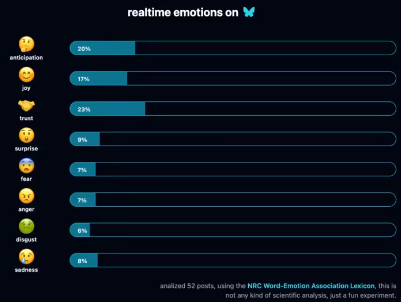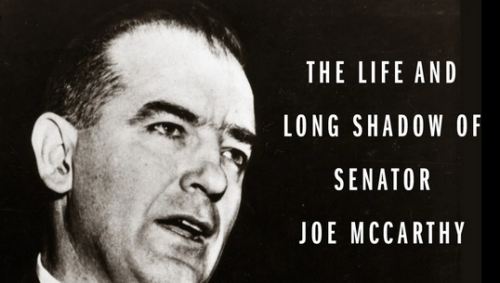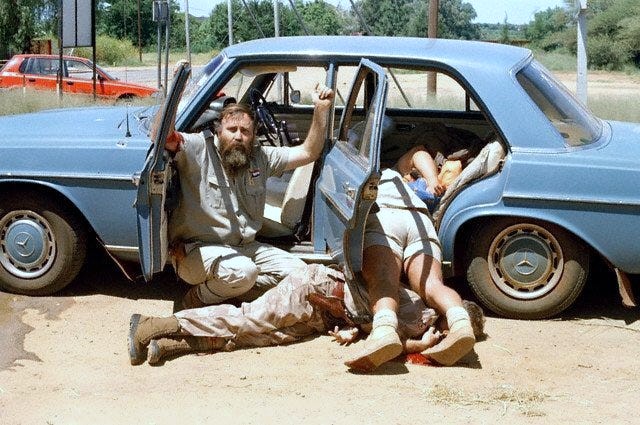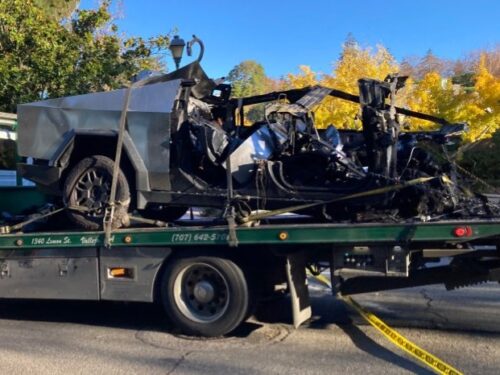Military professionals love a good Clausewitz discussion, especially looking at this past week in Syria. His trinity of people, army, and government has become almost liturgical. It’s the kind of a comfortable framework we apply to everything from counterinsurgency to cyber warfare. But there’s an irony here that Clausewitz himself might appreciate: Our very reliance on his framework demonstrates the human tendency to turn dynamic thinking into static routine.
Perhaps Clausewitz’s best insight, not unlike what has been found in every other profession in the world, was that warfare exists in constant tension between:
- What can be systematized (tactics, drills, logistics)
- What requires judgment (strategy, adaptation, creativity)
But here’s the meta-lesson: The way we invoke Clausewitz has itself become a routine. We’ve turned his warning about the dangers of routine thinking into… a routine way of thinking.
The crystallization of dynamic thought into static procedure appears like a pattern everywhere in human endeavor. Scientific methods become checklist science. Medical diagnosis becomes search engine symptom matching. Strategic planning becomes fill-in-the-blank templates.
The true lesson of Clausewitz thus shouldn’t be reduced to his trinity or his maxims. It comes from recognizing a balance that is often lost, that even our frameworks for handling complexity can become cognitive crutches. His work should be a cradle for military thought, not its grave. The moment we think we’ve fully understood Clausewitz is the moment we’ve missed his point entirely.
I submit that the best way to honor Clausewitz is to recognize when we need to move beyond him, as he argued that each age must write its own book about war. The most dangerous routine might be our routine ways of thinking about how to avoid routine thinking.
The Journal of the United States Artillery once put it like this:
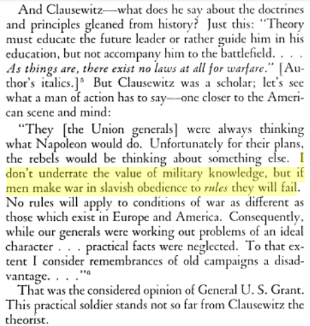
This quote perfectly captures a recursive rule about not following rules slavishly. And the source makes it even more powerful: Grant often was criticized by his contemporaries for being “unscientific” and not following accepted military wisdom, yet he was unquestionably the most successful general of the Civil War, if not all American history.
Even the way we think about thinking needs to avoid becoming dogmatic. The real art is maintaining the tension between structure and adaptability, knowing enough to be competent but remaining flexible enough to be creative.
I’ve heard this as the healthy mental river flow, where we must avoid becoming tangled upon either bank. One is chaotic and forever giving way, the other is rigid and unforgiving. The irony is that this too could become a rigid formula if we’re not careful!
And for what it’s worth, the seditious Confederate General Lee’s rigid adherence to offensive doctrine, a fixation on decisive Napoleonic style measurements, led to several catastrophic decisions.
- Favored aggressive offense to expand slavery, instead of the defensive tactics that were far more strategic to preserve slavery
- Focused on his personal stake in Virginia theater operations despite the war’s center of gravity shift west
- Continued agitating for decisive battle outcomes even after Gettysburg showed this fatally flawed
Grant, by contrast, showed remarkable adaptability and thinking 100 years ahead of his time.
When Grant encountered a problem at Vicksburg, he didn’t just try a different tactical approach, he totally innovated into what was possible. After failed frontal assaults, he executed one of the most audacious campaigns in military history: he marched his army down the western bank of the Mississippi, ran gunboats and transport ships past the Confederate batteries at night (a move considered suicidal), crossed back to the eastern bank well south of Vicksburg, and then lived off the land while cutting loose from his supply lines entirely.
This was mind-bending for the era. Armies were supposed to maintain their supply lines at all costs. Instead, Grant’s troops carrying just five days of rations marched through enemy territory for two weeks, fighting five major battles and confounding both the Confederates and his own superiors. When Lincoln heard of this, he said:
I think Grant has a thought. He isn’t quite sure about it, but he has it.
At Cold Harbor, after suffering heavy casualties in frontal assaults (observing them as mistakes), Grant didn’t retreat to lick his wounds like his predecessors. Instead, he secretly moved his entire army across the James River — a force of 100,000 men with wagons, artillery, and supplies — using a 2,100-foot pontoon bridge. The Confederates didn’t even realize he’d gone until his army was threatening Petersburg.
The Overland Campaign showed Grant’s grasp of both operational art and psychology. Previous generals had retreated after tangling with the “monster” Lee. Grant, instead, kept moving southeast. After each battle, his troops expected to retreat north. Instead, they’d get orders to advance by the left flank. This persistent southward movement had a profound psychological effect on both armies. Union troops began to see they were finally heading toward Richmond, while Confederate troops realized this enemy wasn’t going to quit at first bluster.
Even his staffing choices showed innovation. While other generals relied on West Point graduates, Grant promoted talented officers regardless of background. He elevated leaders like William Smith (originally a civilian vigneron) and James Wilson (who became a cavalry commander at 26) based on demonstrated ability rather than formal education. Perhaps due to his own “self-made” background, he dismissed patronage as irrelevant to performance.
Then there was his approach to intelligence gathering. Rather than relying solely on cavalry scouts and spies, Grant made extensive use of freed slaves’ knowledge of local geography and Confederate movements. This wasn’t just innovative, it echoed his dedication to human value and talent as transformative, recognizing the strategic value of local knowledge that others ignored due to racism.
These weren’t just tactical innovations, they represented a flexible yet practical way of thinking about the world. A fundamentally different path than what came before.
Lee remained fixated on winning decisive battles in a Napoleonic style, while Grant grasped how the Civil War was changing everything, becoming what we’d now call a “total war,” requiring an operational art that combined military, political, and economic elements… not unlike what we’ve seen in Syria lately.
The campaign that best exemplifies Grant’s touch of transformation was his strategic March to the Sea led by Sherman. While Lee was still obsessing about sitting in his tent for his boots to be shined for future battlefield glory, Grant understood that Confederate resistance depended on both military force and civilian will. The March to the Sea was about demonstrating the Confederacy’s aggression as weakness, revealing an inherent inability to protect itself.
Grant had likely not been exposed to Clausewitz, but the Prussian theorist would have recognized in Grant’s strategy the targeting of the enemy’s center of gravity the key to his resistance.
The rise of cyberwarfare, AI, and hybrid warfare demands the kind of adaptable systemic thinking Grant exemplified rather than Lee’s routine and doctrinaire (e.g. racist) approach. So the next time someone waves an ISIS or Confederate flag, just think about it… because it stands as evidence they don’t.





